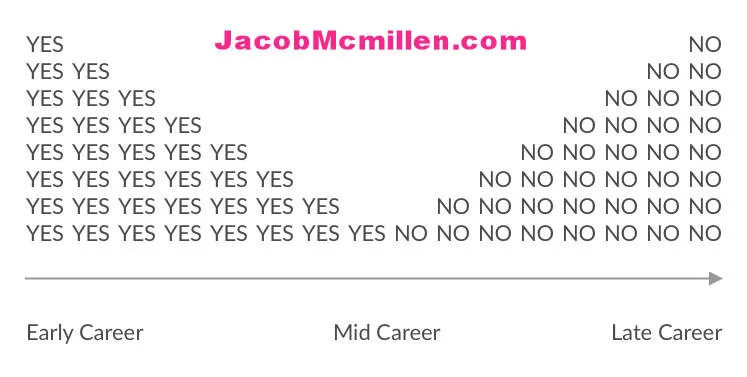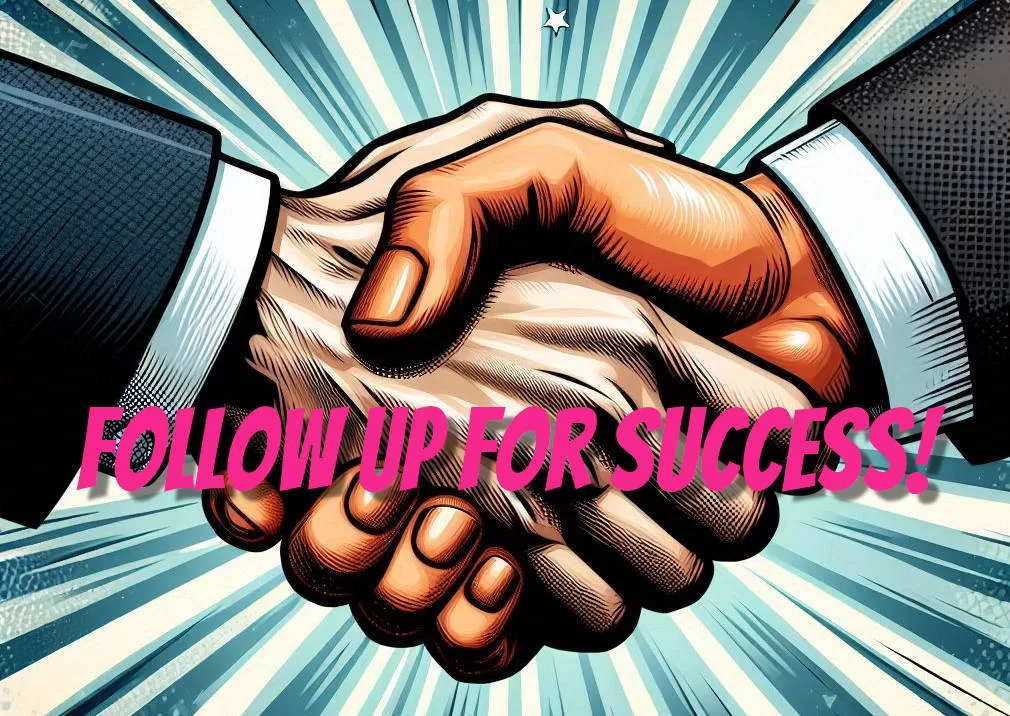Learning how to get copywriting clients is one of the most misunderstood and frustrating aspects of being a freelance writer.
Everyone online claims there’s a fortune to be made as companies are eager to hire writers, but you can’t seem to land a single client.
To make matters worse, you see young copywriters who have apparently cracked the code while your business remains stalled.
Yep, I’ve been there.
The good news is that there’s plenty of money to be made in copywriting.
The bad news is it takes hard and dedicated work to bring in that cash. If you’re going to be in this business, you’ll have to work to get clients.
If you become skilled at writing converting copy, the process of client acquisition gets easier, and clients will seek you out if they like your work.
However, you must pay your dues and sell your services first.
This guide will show you how to get copywriting clients using proven cold DM (direct messaging) strategies, so you can start reeling in the cash your business so desperately needs.
Continue reading right now to learn the cold DM strategies you’ll need to make money in the lucrative business of copywriting.

What is a Cold DM and How Can it Help You Get Copywriting Clients?
Reason #1: You Can Get Direct Access
You’ll be able to directly reach out to owners and decision-makers who need your services, allowing you to introduce yourself and tell them about your services.
Reason #2: Cold DMs Are Personal
Emails often feel impersonal because recipients know they are sent to many people. Even if your email includes their name, it’s apparent the same message has been sent to thousands of others. In contrast, DMs feel more personal, as the recipient perceives the message is for them alone.
Reason #3: You Can Give Your DMs a Personal Touch
Expanding on Reason #2, sending a well-written DM can feel like sending a personal letter to your prospects. This personal touch is crucial because it increases the likelihood of engagement.
Reason #4: Engagement is Immediate
Social media platforms are designed for real-time interaction, so a DM can elicit a faster response than email or direct mail.
Reason #5: Networking Opportunities Abound on Social Media
Even if you don’t land a prospect as a client, you can develop a relationship that may lead to other prospects and opportunities down the line.
Reason #6: Outreach to Targeted Individuals
Platforms like LinkedIn have advanced search filters that help you find and reach out to specific individuals. For example, you can search for executive coaching services or executive coaches, view their profiles, and determine if they fit your ideal client persona.
Reason #7: DMs Are Cost-Effective
Sending cold DMs is free. You can send out many DMs on LinkedIn, Instagram, Facebook, and Twitter (X) at no cost. LinkedIn, for instance, allows you to send free messages to people in your 1st-level connections. (There are several ways to expand your 1st-level connections, which I will discuss later in this post.)
Professionals Who Use Cold DMs to Get Clients
If you need a bit more convincing on the effectiveness of cold DMs, here are some notable professionals who have successfully used this technique:
- Bob Bly: Known as the copywriter’s copywriter, Bob Bly has over 97 published books and hundreds of information products to his credit. He started with cold DMs via direct mail even before the Internet became widespread.
- Carol Tice: An A-list copywriter with an impressive roster of corporate and private clients. Carol not only teaches her Copywriter’s Den students how to use cold DMs, but she also demonstrates the technique on LinkedIn.
- John McIntyre : The Auto Responder Guy and one of the world’s top email copywriters. John built a six-figure business within 12 months using cold DMs.
So, there you have it. If they can do it, you can too.

How to Start Using Cold DMs to Get Clients
Professionals Who Use Cold DMs to Get Clients
If you need a bit more convincing on the effectiveness of cold DMs, here are some notable professionals who have successfully used this technique:
- Bob Bly: Known as the copywriter’s copywriter, Bob Bly has over 97 published books and hundreds of information products to his credit. He started with cold DMs via direct mail even before the Internet became widespread.
- Carol Tice: An A-list copywriter with an impressive roster of corporate and private clients. Carol not only teaches her Copywriter’s Den students how to use cold DMs, but she also demonstrates the technique on LinkedIn.
- John McIntyre: The Auto Responder Guy and one of the world’s top email copywriters. John built a six-figure business within 12 months using cold DMs.
So, there you have it. If they can do it, you can too.
How to Start Using Cold DMs to Get Clients
You’re probably going to feel intimidated sending out cold DMs at first, but don’t worry. I was terrified the first time I sent out DMs online.
In fact, I once sent a sales letter style DM via direct mail, and the second word in the headline was misspelled. To make it worse, I sent it to professional advertising agencies. (Man, I bet they laughed their asses off.)
So, if you’re worried about making a mistake, a little respect here – for I am Elmo, king of the screw-ups.
Feel the Fear and Do It Anyway
Yes, you will make mistakes, get a lot of rejections, and face some criticism. So what? Let the fear pass and keep on trucking. After sending out several hundred cold DMs, you won’t feel fear much. You’ll get tired and a bit bored, but you won’t be scared. Guaranteed.
As a matter of fact, when you write and send cold DMs to get clients, you’ll feel more like someone who had a big dinner and was forced to watch the chrome on a car corrode for hours on end. Yeah, it’s not nearly as scary or exciting as a rollercoaster ride.
Focus on These Simple Aspects
Let me break down the process for you to make it easier to follow. First, approach it methodically. What do I mean by that? Chop up the process into smaller, clearer chunks or steps. These steps need to be manageable and well-structured in an organized way so that the process becomes second nature to you over time. You will need at least four different processes:
- Initial Outreach: Create a template for your initial outreach to prospects.
- Follow-Up Messages: Develop follow-up messages to keep your initial contacts engaged.
- Handling Rejections: Have a message template ready for prospects who say, “No.”
- Setting Up Meetings: Craft a message that sets up a first meeting or chat.
Having these four processes in place will put you far ahead of everyone else prospecting using cold DM marketing.
Find Your Niche First
Don’t worry if you’re unsure about how to find your ideal niche—I’ve got you covered in another extensive lesson. I’ve broken down the entire process for you and even added a few of my own niche-finding hacks. Click the link above for a deep dive into finding your ultimate niche.
Prepare Your DM Strategy to Get Clients
A lot of people usually try to get clients before setting a strategy. However, you must do this first; otherwise, you’ll end up sending out DMs to people who aren’t interested. One of the reasons I wrote an entire lesson on identifying a niche is because without a specific target, you’ll waste a lot of time and money. It’s like trying to hit a moving target blindfolded.
Your well-defined strategy will include personalized messages that are focused and relevant. They will address the pain points your prospects are feeling, which will translate into “you get them and what they need.”
Additionally, you’ll need to set up a way to measure and track your efforts and successes so you’ll know what works and what doesn’t. This way, you can refine your processes and improve them over time. Having an organized and consistent process will also save your most precious asset—time. It will allow you to allocate your time and resources more effectively, increasing the chances of converting your prospects into clients.
So, having a planned roadmap and a way to track your progress in client acquisition is essential.

How to Set Clear Objectives to Get Clients
If you don’t set objectives, you’ll have no way of knowing if you are attaining your goals. And if you don’t do this early on, there is a very good chance that you’ll get frustrated and quit. Believe me, I’ve been close to the edge myself because I didn’t prepare on the front end.
Step 1: Define Your Goals
Set specific, measurable goals like contacting 50 prospects or securing 5 clients a month.
Step 2: Break Them Down
Break the bigger goals down into smaller goals if needed. For example, you need to find prospects.
First, identify where you will locate them. Next, qualify them as your niche market. Finally, collect their contact data and put it into a spreadsheet.
Step 3: Set Milestones and Reward Yourself
Once you’ve broken down your cold DM goals, set milestones for yourself.
It has been scientifically proven that people who set these targets and then reward themselves have a higher productivity rate. (Atomic Habits: An Easy & Proven Way to Build Good Habits & Break Bad Ones, James Clear, Avery Publishing, 2018)
Step 4: Ensure Your Goals Are Realistic
It’s one thing to set impressive goals for yourself, it’s another to achieve them. If you set a goal to make six-figures in your first year, you may end up disappointed.
Setting goals that you can realistically achieve will keep you from getting depressed and stagnating.
Tip: Set a goal that is just under what you believe you can achieve, so you can surpass it and feel even better. However, only you know your limits, so set them with your own personal capabilities in mind.
Step 5: Align Your Objectives
If you want to build your copywriting venture into something bigger, like a full-blown agency, then make sure these goals fit into that overall plan.
Step 6: Keep Flexibility in Mind
Prepare to adjust your goals based on results and feedback from prospects.
Sooner or later, you’ll figure out what works and what doesn’t, and you can tweak your plans so the process doesn’t wear you out or become frustrating.
Following those 6 steps should help you define your cold DM strategies and take action. If you take them seriously and stay organized, there’s no reason why you can’t hit your target and enter the winner’s circle.

Tasks to Do Before Crafting Your Cold DMs
Know Your Audience
The more you know about who you are sending your DMs to, the better off you will be. This will make it much easier for you to get copywriting clients—you won’t believe it.
The more you know about their demographics like age, gender, location, etc., the better. However, I believe knowing the psychographics is even more important and often overlooked. Psychographics are the thought processes like motivation, interests, values, and pain points that your prospects have.
Uncovering Your Prospects
One of the things I hate a lot is people asking me to take a survey. Think about it. You are asking me to tell you marketing information about myself and you want me to do it on my time, which is my most valuable asset, for free. And who will benefit from this? Not me, that’s for sure.
A lot of the advice you read online is also based on the idea that you already have an email list that you are writing to. If you don’t have a large email list to send a survey to, forget about it. Out of 1,000 people surveyed, only 1 to 5 of them will answer it.
So, if you don’t have a massive following of raving fans that love you, forget about it.
That’s just my opinion, but if you want to send out a demographic survey, go for it.
My way of doing this is much easier and simpler. It is time-consuming, but it beats the crap out of sending out a survey.
How I Qualify My Prospects
Here is the way I qualify people to see if they are a good fit for my business and to also find out what makes them tick.
The criteria for my list will probably be different from yours, but no biggie. This method will work for any niche or personality type.
Before I show you how I gather my intel on my prospective clients, here is what I’m looking for in a client:
Identify Who You Want First
My Niche:
Executive coaches or executive coaching businesses
Business/Financial Level:
Mid to large coaching businesses (not the really big multimillion-dollar coaches). Must be pulling in at least $40,000 a year in revenue.
Marketing Assets:
They must have a website and be consistently active on a social media platform like LinkedIn, Medium, Facebook, Instagram, Quora, or other. This is important because I’m a copywriter. Copywriters reside in the marketing realm, and if they don’t have a way to market their business, they won’t be a good fit for me. If I have to convince someone to market their business, chances are I’ll never get them to do it.
Trust me on this: if you see a candidate who is clueless about marketing…Run!
Write this adage on a piece of paper where you can see it:
“A person convinced against their will is of the same opinion still.”
Problems Prospects Have:
They must have some sort of problem that I can help them with. Since I am an email ghostwriter, it would be ideal if they were lacking something in the email department. Usually, prospects that have a mid-range business have a problem keeping up with a consistent email marketing campaign or plan.
However, since I have experience in writing blog content, if they have a blog, I can pitch them in that vein too. Sometimes that can lead to working with them long-term on email projects.

Spy on Your Ultimate Prospects
Once I’ve taken the first step in how to get clients, it’s time to take a closer look at them to see what they need and what concerns them.
Once again, this is my process and it is a little time consuming, but well worth the effort.
Check Out Client’s Social Media and Websites
Once I can see these are the kinds of prospects I’m looking for, I need to look at what they are reading and writing about. In my case, I’ll look at their LinkedIn (LI) posts and profiles.
The reason why I love LI as an information source is because people are there to exchange ideas and information about business. LI is a business social media site with over a billion users.
Business people, of in my case, executive coaches and coaching business post what they are thinking about on these sites.
And if you are having trouble finding people in you niche, you can always join one of the dedicate groups. One of the executive coaching groups on LI has over 300,000 members. So, it is very easy to meet with and connect with like-minded people.
Are These Prospects Active?
One of the biggest concerns I have about how to get clients, is seeing if they are actively promoting their businesses.
And once again, LI is perfect for finding this out. All you have to do is go to their profile page and look at their information.
Here’s a rundown of the information you can glean from a LinkedIn profile:
Name: Basic, but essential.
Headline: Often gives a snapshot of their current role or career focus.
Current Position: Where they work and their job title.
Previous Positions: Work history and job titles at previous companies.
Education: Where they studied and what degrees they earned.
Location: Where they are currently based.
Industry: The field they are involved in.
Summary/About Section: A brief description of their professional background and expertise.
Experience: Detailed work history with roles, responsibilities, and accomplishments.
Skills and Endorsements: Specific skills they have been endorsed for by their network.
Recommendations: Testimonials from colleagues and clients.
Accomplishments: Includes publications, certifications, patents, courses, projects, honors, and awards.
Interests: Companies, groups, and influencers they follow.
Contact Information: Email addresses, phone numbers, and links to websites or other social media profiles.
Read Their Posts
Yes, you can get a lot of valuable information, but if you really want to know what makes them tick, check out their posts.
Where do you find their posts?
Go to their Profile page à Scroll down to Activity àScroll down further to All Activity à Click on that
You will then be taken to a page that has every post they’ve ever written on LinkedIn. You can scroll through it all and see what they’ve written, shared, and commented on.
Reading their thoughts will give you a good idea of what their psychographic profiles are like. (I mentioned this earlier. Some of it is the stuff that keeps them awake at night.)
Look at Their Websites
If you want to get a clear picture of what your prospects are thinking, look at their websites.
Where can you get their website address from?
Got to their Profile page à Click on Contact Info à A popup menu will appear with a website and other contact info on it.
Usually, I disqualify prospects if they don’t have a website.
Having a serious business without a website, wreaks of not really being serious, if you know what I mean.
The website doesn’t have to be massive, but they should have one.
The only way I will consider a prospect without a website is if they have a tremendous social media presence. If they have 400+ videos on YouTube that are niche focused, I’ll keep them on my list.
Look at These Website Assets
If the prospect has a blog, about page, contact information, or detailed pages that look and read professionally, I’ll scour them for ideas on how the prospect thinks.
Also, take the time to read their client lists and testimonials. If there are names on the testimonials and those people are on LI, reach out to them and ask them what they liked about working with your target prospect.
You can also ask them if it would be OK to mention their name in your pitch. Anything you can do to move the ball further down the field in acquiring a client is good as long as you get permission to do so.
Grab Some Common Ground
Remember when I told you to spy on your prospects? What you should do is find a blog post, article, award they have won, or something about your prospect that you could mention at the forefront of your message.
For example, if you can mention that you read an article on LinkedIn or Quora that they wrote and how it helped you in some way, that is gold—pure gold!
Let me give you an example of one of the messages I’ve sent so you can see what I mean. Here is the beginning of a pitch for my copywriting services that I sent to a life coach:
“Hello Sai,
I recently explored your YouTube channel and immersed myself in several of your insightful video sessions.
Among them, your take on picking a niche resonated with me, especially since I’ve just wrapped up a 3000-word post on the same topic. Funny how life synchronizes those wavelengths, right?”
So, I actually watched his videos and then included that fact in the pitch.
This gives us some common ground.
In my opinion, this makes my cold DM sound not so cold and more like I had a genuine interest in what he was doing. (Which, if you really want to write for someone, you should genuinely take an interest in what they’re doing.)
Yes, watching videos does take time, but most videos published online have a way to speed them up. So, I watched his videos at 1.5x speed and wrote down a few important notes.
Don’t Spend Too Much Time
If you’re like me and prefer to stick to reading things posted on social media, it is even easier.
Let’s say you are following someone who has a Facebook business page and they made a post about buying a motorcycle. If you have a shared interest in that, then mention yours and what kind of bike you have in your DM.
At the very least, the prospect may start a conversation and a friendship with you. This brings up another point: they may not buy from you now, but later, they may.
So, try to find some common ground because it sounds much better than jumping into your pitch like an impatient salesperson.
Get Clients by Keeping It Simple
You don’t want to overdo this “common ground” thing. You want to use it like salt and pepper.
Keep it light and just mention it in a few sentences.
The reason for this is you must assume these people are very busy. You don’t want to interrupt their busy day with a long-winded message. Besides that, it will be extremely time-consuming for you.

The Get Clients Cold DM Framework
Click Here to Get These Cold DM Templates
I am now going to give you two frameworks that you can use.
One is the more personal one that you can use if you want to apply the “common ground” method I just told you about.
The other one is a simple one that you can use without any common ground. It is built for speed and for people who have a massive list of prospects they want to send a ton of cold DMs to.
The Common Ground Framework
Personalized Intro – Use their name.
Hello Sai,
Common Ground – Mention something you read or saw bout them.
I recently explored your YouTube channel and immersed myself in several of your insightful video sessions. Among them, your take on picking a niche resonated with me, especially since I’ve just wrapped up a 3000-word post on the same topic. Funny how life synchronizes those wavelengths, right?
Now, here’s the twist: While you’re navigating the coaching world, I was busy addressing copywriters. Parallel universes, perhaps?
And let’s talk about those four crucial points you dropped at the end of your video. They’re like the secret spices in a master chef’s recipe—essential for identifying the niche where you truly shine.
Give Them Something to Think About – You can give them a relatable statistic or fact.
Now, Sai, I bet you’re wondering why this digital messenger pigeon has flown your way. Well, wonder no more! I’ve got exciting information that could impact your videos and channel.
Here are two video stats for 2024 you may want to look at:
68% of marketers who don’t use video say they plan to start using video in 2024. That means that over the next few years, there will be a lot of coaches jumping on this bandwagon.
Address a Pain Point – Show them that you feel their pain.
Do you know what the #1 barrier to making videos is? Lack of time.
So, if you’re planning to stay ahead of this game, you’ll need to leverage your time. That’s where I come in.
You Are the Solution – Tell them how you can help them with this problem.
As a copywriter with over 30 years of experience, I understand how time-consuming writing video scripts can be. In fact, I’m sure you face these script challenges:
- Clarity and Conciseness: Ensuring your message is clear and to the point.
- Engagement: Creating content that captivates your audience.
- Planning: Sequencing and planning your videos effectively.
- Tone and Style: Maintaining a consistent tone and style.
- Editing: Ruthlessly editing to perfection.
- Content Calendar: Organizing a content calendar.
I’ve noticed that your channel currently has close to 2,000 subscribers, and it’s evident that you’ve already poured a lot of effort into your content. Your natural talent shines through—your articulation and delivery are impressive.
But imagine the impact you could make if you took things up a notch or two and truly made your videos outstanding. Picture this: 20,000 to 50,000 subscribers eagerly tuning in to hear your insights, and a significant boost in your coaching revenue.
Guess what?
Street Cred – Show them you have earned your stripes.
I can help you get there.
Not only have I written and created a wide range of videos, but I’ve also crafted content for Paperbell, the U.S. Army, Stathis Strategies, and many other institutions and businesses.
Here’s the thing: I’ve set a personal goal of meeting and talking to 50 prospects a month. (Yeah, that’s not a lot, but I screen and evaluate everyone I send a pitch to.)
Offer Something – Offer to give them something for free.
To help you out, I’m offering a free personalized audit with actionable feedback for one of your YouTube videos. I’d be more than happy to provide this service if you book a call or a Zoom meeting with me. I promise not to try and “sell” you anything!
Call to Action – Tell them (don’t ask them) to contact you.
Just call or email me, and we can set up a time.
Sign Off
Best regards,
Thanks,
Mark Elmo Ellis
ElmoCopy.com
(859) 797-9560
Post Scripts – If you can add more credibility to your message do so here.
P.S. Here are a few comments from my satisfied clients:
“Mark has written for two of my companies, and his posts and video scripts have brought in more readers and viewers than we could have imagined. Thanks, Mark!”
Chris Jackson
Owner, Warrior Wealth Solutions, Stathis Strategies
Don’t Get Overwhelmed by This Cold DM
This was the ultra-deluxe, massive-value, blow-the-mind-of-your-prospect version.
YOU DO NOT HAVE TO MAKE IT THIS LONG.
I provided it so you can pick and choose the parts you want to use.
As I mentioned before, you shouldn’t make the common ground part too long—just a few sentences will do.
Just to show you what a swell guy I am, here is a simpler version you can use.
The Simplified Cold DM Framework
Personal Intro
Hey Sai,
Give the Pitch
I’m a [niche] freelance copywriter and I would love to write for [his company’s name]. Do you need to have [type of content] written for your company?
Mention What You Do
I specialize in [content types], and I’m sure you could use my services.
Give Them Something to Look At
Here is a link to some of my [writing niche] samples:
I Would love to run a few ideas by you.
Give a Call to Action
When would it be a convenient time to discuss these?
Or This Stronger Call to Action
Call me today, so we can discuss these!
Thanks!
[your name]
Oh, Snap! My Prospect Said “No”
I guess, I should have mentioned this earlier, but you will face a lot of rejection.
Selling your services is a sales job, no question about it.
And anyone in a sales position should realize quickly that there will be a lot of people who will say “no” to your offer.
Years ago, I was a network marketer, selling products for a company. I learned a ton about business from selling their products and services because they had great seminars on selling.
One of the top producers at the company was an Asian lady who had an incredible attitude about rejection.
Her motto was, “Some will. Some won’t. So what?”
And that is the attitude you have to have if you’re going to be a freelance copywriter.
This Graphic Should Be Your Goal
The copywriting teacher, Jacob McMillen, has a graphic on his site that explains the trial every freelance copywriter experiences. Here’s what it looks like:

(I’ll bet you were expecting it to be the opposite; “No’s” on the left, “Yes’s” on the right.)
What this chart illustrates is that when you’re just starting out as a freelance copywriter, you should take every gig you can. In other words, say “yes” to everything.
Yeah, you’ll feel like a copywriting garbage man for a while, but keep on trucking and you’ll start making solid money and getting better clients.
This will help you build your skills and get you some testimonials, which will help you get even more clients.
Look at the chart again.
When you start out, you’ll be saying YES to everyone you can, but after your midcareer leap, you’ll be the one who is saying “No.” That’s right, after you have some successes in your copywriting venture, YOU CAN BE THE ONE WHO IS PICKY AND SAYS NO TO CLIENTS.

You Must Track Your Work
This is a step you cannot skip; you must keep a record of who you are contacting. There are several reasons why you need to keep track of your progress.
First, you need to see how many people you are connecting with over a set time period. It is very important to have established goals set in your prospecting to get clients. Having a set number of people to contact will keep you motivated and on task in marketing your copywritng business.
Second, you need to remember who you have contacted. One important reason for this is so that you’ll be able to follow up with them, later. 99% of the time, people will not bite on the first thing you sent them. (More on this in a minute.)
Third, if someone sends you a message telling you they are not interested in your offer, then keep track of it. You don’t want to keep sending them messages they don’t want and hack them off. However, you can probably contact them later on, like a year later, just to check on them.
Use a Spreadsheet for Cold DMs
Click Here to Get a Formatted Google Sheet to Track Clients
I use a Google spreadsheet to keep track of my prospects. Of course, I could use Microsoft Excel, but I’m a cheapskate and use Google because it’s free. Here is a screenshot of my spreadsheet so you can see how I compile this information.
I try to keep my spreadsheet as simple as possible because when I’m adding prospects to the list or updating their status, I don’t want to spend a lot of time on it. So, my advice to you is to keep it as simple as possible.

Follow Up for Success
One thing you should keep in mind is that you should always follow up. My rule of thumb is this: follow up until they tell you to stop.
So, if it takes 20 times before they book you or tell you to stop, then do so.
I can’t tell you the number of times that I’ve sent out messages almost 6 or 7 times and all of a sudden, a client says something like: “Elmo, so sorry it has taken a while to get a hold of you. Let’s set a date to get together so we can talk about this project more.” Or something like that.
Two Ways to Follow Up
Let’s face it, if you really want to be a copywriter and get clients, following up is a key element in your plan.
However, there are at least two methods of following up that you can do.
Follow Up Method #1: The Fast and Simple Method
With this follow up, all you do is say something like this:
Hey Joline, I just wanted to follow up on the email I sent you on October 22nd. I’m just wondering if you got it and would like to schedule a time to talk.
Many apologies for interrupting your busy day.
Sincerely,
Mark Elmo Ellis
Elmocopy.com
And each time you send it, just tell them you are sending a reminder or something like that. Keep it natural and short.
Follow Up Method #2: The Value-Added Method
With this method of following up, you are adding value to your message that your ideal prospect can use.
So, here is a follow up that adds value:
Hi Jolene,
I just wanted to follow up on the email I sent you on October 22nd. I’m just checking back with you because
I’m sure I can help you achieve the goals you’ve set for yourself as an executive coach.
One thing I’m absolutely sure of is I can reduce the amount of time it takes for you to create an engaging email sequence. For most coaching businesses, time has to be strictly managed so you can attend to more important facets of your services.
I can help with that by crafting your email messages for you.
Let’s get together so we can get started on saving your most important asset, time.
Many apologies for interrupting your busy day.
Sincerely,
Mark Elmo Ellis
Elmocopy.com
If you are focused as a copywriter in a specific niche and are approaching the same kind of people over and over again, adding value won’t be hard because you’ll be using the same message over and over again for each prospect.
However, if you are approaching a lot of people in different niches… Well, you’ll be doing a lot of writing.
(See why it’s so important to focus on one niche?)
Conclusion
This post is well over 5000 words because I wanted to make sure you had all the information possible on how to get started pitching clients for your copywriting business.
I want you to bear one thing in mind: you are selling your services to professionals. For every one of the prospects you send a pitch to, they have probably gotten hundreds of pitches sent to them. At the very least, that is the attitude you need to have. This is a selling game and a numbers game.
You must be persistent, patient, and expect to get a lot of rejections.
So, here’s some final advice.
You have the Internet at your disposal, so seek out highly positive messages on podcasts and online videos.
You need to get your attitude pumped up. Seek out advice from some of the world’s top salespeople. Also, seek out dedicated forums and groups that are for copywriters.
Develop a support group and no matter what happens, never lose sight of your dream to get clients and become a professional copywriter.
I believe in you.
Please, leave a comment and let me know how this post on sending cold DMs has helped you.

Every response is a good response, especially on LinkedIn. Even if your response, in turn, is ‘no worries,’ although I might say in response to a thank you but no thank you. Is: ‘no worries. Thank you for letting me know. I wrote because I have worked in your specific industry, and I would be delighted to share some insights I have discovered I think you might find useful’
David, Thank you so much for your comment, my friend. I agree getting a response is definitely better than nothing. At least it lets you know that the message is getting through. God bless, my friend!